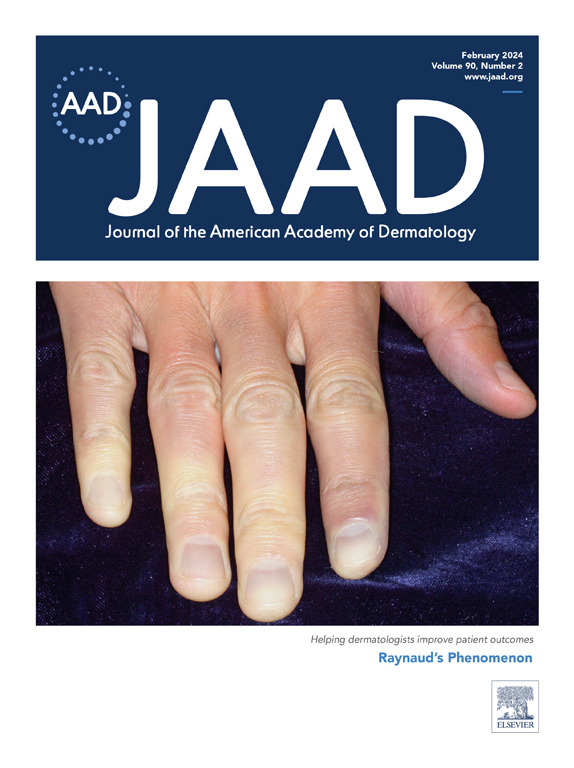The epidemiology of dermatofibrosarcoma protuberans incidence, metastasis, and death among various population groups: A Surveillance, Epidemiology, and End Results database analysis
IF 12.8
1区 医学
Q1 DERMATOLOGY
引用次数: 0
Abstract
Background
Limited information exists regarding the epidemiology, metastasis, and survival of dermatofibrosarcoma protuberans (DFSP).
Objective
To measure DFSP incidence and assess metastasis and survival outcomes.
Methods
Incidence rate, overall and DFSP-specific survival outcomes for primary DFSP tumors contained in the Surveillance, Epidemiology, and End Results (SEER) registry were analyzed via quasi-Poisson regression, Cox, and competing risk analyses.
Results
DFSP incidence rate was 6.25 (95% CI, 5.93-6.57) cases per million person-years with significantly higher incidence observed among Black individuals than White individuals (8.74 vs 4.53). DFSP with larger tumor size (≥3 cm, odds ratio [OR]: 2.24; 95% CI, 1.62-3.12; P < .001) and tumors located on the head and neck (OR: 4.88; 95% CI, 3.31-7.18; P < .001), and genitalia (OR: 3.16; 95% CI, 1.17-8.52; P = .023) were associated with significantly increased risk of metastasis whereas higher socioeconomic status was associated with significantly decreased risk of metastasis. Larger tumor size (≥3 cm), regardless of location, and age (≥60 years) were associated with significantly worse overall and cancer-specific survival.
Limitations
Retrospective design of SEER.
Conclusion
DFSP incidence is 2-fold higher among Black than White individuals. The risk of DFSP metastasis is significantly increased with tumor size ≥3 cm and tumors located on head and neck, and genitalia. Larger tumor size (≥ 3 cm), regardless of location, and age (≥60 years) are the most important prognostic indicators of survival.
不同人群中原发性皮纤维肉瘤发病、转移和死亡的流行病学:SEER 数据库分析。
背景:有关皮纤维肉瘤(DFSP)流行病学、转移和存活率的信息有限:有关皮纤维肉瘤(DFSP)的流行病学、转移和存活率的信息有限:测量 DFSP 的发病率并评估转移和生存结果:方法:通过准泊松回归、Cox和竞争风险分析,对监测、流行病学和最终结果登记处(SEER)中包含的原发性DFSP肿瘤的发病率、总生存率和DFSP特异性生存结果进行分析:DFSP发病率为每百万人年6.25例(95%CI,5.93-6.57),黑人的发病率明显高于白人(8.74 vs 4.53)。肿瘤尺寸较大的 DSFP(≥3 厘米,Odds ratio,OR,2.24,95%CI,1.62-3.12,p 局限性:结论:黑人的 DFSP 发病率是白人的 2 倍。肿瘤大小≥3 厘米、肿瘤位于头颈部和生殖器部位的 DFSP 转移风险显著增加。较大的肿瘤大小(≥3厘米)(无论位置如何)和年龄(≥60岁)是影响生存的最重要的预后指标。
本文章由计算机程序翻译,如有差异,请以英文原文为准。
求助全文
约1分钟内获得全文
求助全文
来源期刊
CiteScore
8.60
自引率
5.80%
发文量
2023
审稿时长
49 days
期刊介绍:
The Journal of the American Academy of Dermatology (JAAD) is the official scientific publication of the American Academy of Dermatology (AAD). Its primary goal is to cater to the educational requirements of the dermatology community. Being the top journal in the field, JAAD publishes original articles that have undergone peer review. These articles primarily focus on clinical, investigative, and population-based studies related to dermatology. Another key area of emphasis is research on healthcare delivery and quality of care. JAAD also highlights high-quality, cost-effective, and innovative treatments within the field. In addition to this, the journal covers new diagnostic techniques and various other topics relevant to the prevention, diagnosis, and treatment of skin, hair, and nail disorders.

 求助内容:
求助内容: 应助结果提醒方式:
应助结果提醒方式:


